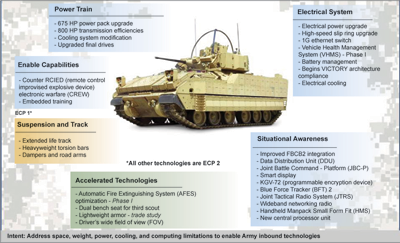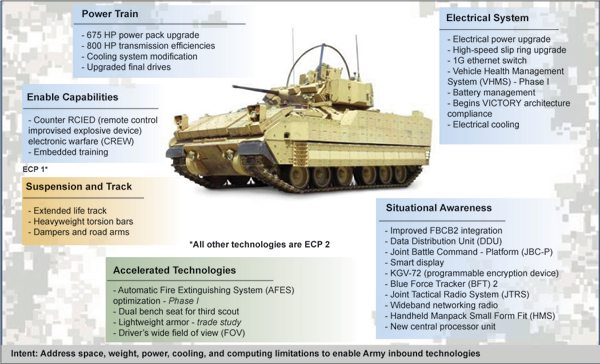Bradley Family of Vehicles Undergoes Engineering Change Proposals
by MAJ Nayari Cameron

Figure 1 — Bradley ECP 1 & 2 Technologies
When the West began its ascent to world supremacy in the 16th century, military institutions played a crucial role in its drive to power. Recent historical work suggests that the Western military framework has undergone cyclical periods of innovation beginning in the early 14th century and continuing to the present and that such periods have resulted in systemic and massive changes to the basic nature of warfare and the organizations that fight.* The military history of the 20th century indicates that this pattern has continued unbroken except that the periods between major innovations have been decreasing even as the complexity of innovation has increased.
A number of factors have driven innovation in military affairs: the rapid pace of technological change, the vast sums spent on military research, and the increasing sophistication with which military organizations evaluate their performance and that of their weapon systems. The fusion of technology and potent management skills that mobilize mass organizations makes military change inevitable. If anything, the technologies influencing civilian life in the next century may have even greater impact on military force than has been true in this century.
As the user representative, the U.S. Army Training and Doctrine Command (TRADOC) Capability Manager Armored Brigade Combat Team (TCM-ABCT) continually assesses the capabilities of the Bradley family of vehicles (BFoV) in coordination with ABCT commanders to ensure organizations are properly organized, trained, and equipped for success on the battlefield. Over the course of 30 years, the BFoV has continually evolved, adding technologies ahead of its adversaries making it one of the Army’s most combat effective families of vehicles. In the wake of combat operations in Afghanistan and Iraq, lessons learned reflect the need modernize once again as emerging technologies continue to flow into the system at a rapid pace. In the near future, the Bradley will be upgraded with improved underbelly protection and will also be linked to the Army’s network via a mission command suite. Network improvements provide the commander the ability to maintain non-interrupted higher, lower, and adjacent communications with all elements of the brigade sustaining situational awareness during decisive actions while on the move. The improvements in networked communications also provide the ability to maintain situational awareness between mounted and dismounted Soldiers including voice, digital, and video capabilities.
Today’s BFoV are at, or exceeding space, weight, and power cooling (SWaP-C) limitations. To address this issue, the Maneuver Center of Excellence (MCoE) began a modernization initiative in 2007 to update requirements documents with the intention of restoring lost platform capability and gaining sufficient SWaP-C margins to host future technology inserts. The Vice Chief of Staff of the Army (VCSA) directed all work on Abrams, Bradley, and Stryker modernization to cease during the 2011 Combat Vehicle Portfolio Review (August 2011) and issued guidance that established a new combat vehicle strategy that transforms capabilities for the BFoV using engineering change proposals (ECP) in increments.
During a briefing with the VCSA and Army Acquisition Executive (AAE), the ABCT program manager recommended a two-phase approach to combat vehicle modernization (CVM). The AAE and VCSA concurred with the two-phase approach, and the AAE made the stipulation that the program manager return within one year from the date of the acquisition decision memorandum (ADM) and present the Phase II effort to carry to the Defense Acquisition Executive regarding the major systems upgrades of the Abrams and Bradley platforms in accordance with the Army’s long-range CVM strategy for Fiscal Year 2017 and beyond.
In phase one, Bradley will undergo two separate ECPs; ECP I and ECP II. ECP I provides track and suspension upgrades to regain lost mobility/ground clearance and support additional weight due to the addition of the improvised armor and the Bradley urban survival kits (BUSKs) I, II, and III kits. ECP II provides both electrical and mechanical power-based upgrades which improve automotive performance and enable/host the integration of electronics and communication enhance-ments required for network interoperability. Electric power generation and distribution aspects of the Bradley ECP II include the addition of a second alternator, high speed slip ring, power control module (PCM), data distribution unit (DDU), and battery monitoring system (BMS). These updates provide the additional power needed in the turret and the means for transporting the power. The modified slip ring will have the capability to pass increased radio frequency and power to the turret. Because of the changes to the alternator and the slip ring, the Bradley requires upgrades to the PCMs as well. The BMS enables the user to monitor the current status of the batteries used for initiating and maintaining silent watch capabilities. ECP II mechanical power upgrades consist of a 675HP engine, 800HP transmission, modified power take-off assembly, and improved final drives.
ECPs I and II were developed and funded to address SWaP-C deficiencies and enable the vehicle to accept various incoming technologies. They are not sufficient for the long-term viability of the BFoV. Therefore, an additional ECP (ECP III) is necessary. ECP III technologies are required to mitigate existing formation gaps, restore threshold capabilities of approved operational requirements and build a margin for future growth. As we look at the combat requirements of the future and the current fiscal realities, continued adaptation of the BFoV is inevitable to support the hybrid threat operating environment. TCM-ABCT will continue to identify ways to keep the BFoV on pace to host future modernizations and will continue to identify ways to make the ECP program better for the Soldier of today, and the Soldier of tomorrow.
* Williamson Murray and Allan R. Millet, Military Innovation in the Interwar Period (United Kingdom: Cambridge University Press, 1998).
MAJ Nayari Cameron is currently serving as the Assistant TRADOC Capability Manager (ATCM) Armored Brigade Combat Team (ABCT) as the Bradley Team lead. His previous assignments include serving as commander of Bonecrusher Company, 2nd Battalion, 353rd Infantry, 162nd Infantry Brigade; assistant regimental operations officer, 16th Cavalry Regiment, Fort Knox, Ky.; staff maneuver trainer, 2nd Battalion, 2nd Brigade, 5th Division Military Transition Team, Baquba, Iraq; executive officer, C Company, 3rd Battalion 81st Armor Regiment, Fort Knox; assistant operations officer and platoon leader, 4th Squadron, 7th Cavalry, South Korea.

 Share on Facebook
Share on Facebook email
email print
print